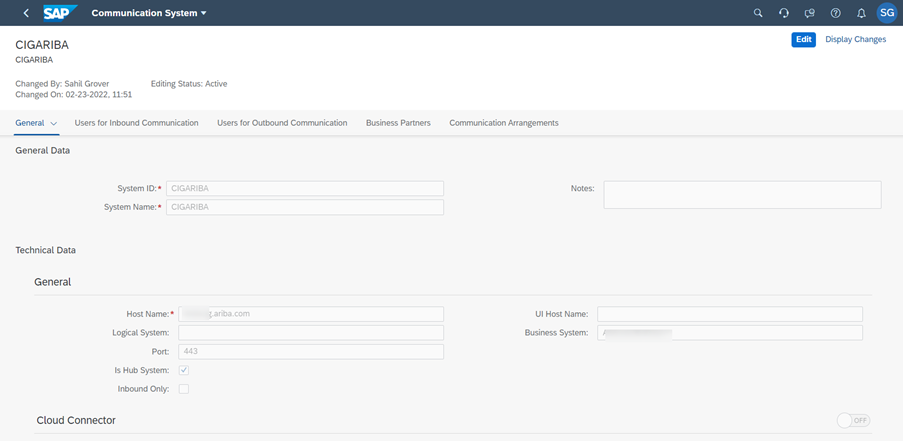
- SAP Community
- Products and Technology
- Spend Management
- Spend Management Blogs by SAP
- Technical configuration in S/4HANA Cloud for integ...
Spend Management Blogs by SAP
Stay current on SAP Ariba for direct and indirect spend, SAP Fieldglass for workforce management, and SAP Concur for travel and expense with blog posts by SAP.
Turn on suggestions
Auto-suggest helps you quickly narrow down your search results by suggesting possible matches as you type.
Showing results for
Product and Topic Expert
Options
- Subscribe to RSS Feed
- Mark as New
- Mark as Read
- Bookmark
- Subscribe
- Printer Friendly Page
- Report Inappropriate Content
04-21-2022
12:30 PM
Introduction
This is the second blog post in the series and in this blog post we will see the technical configuration set up in S/4HANA Cloud .
Part 1 : Ariba Integration with S/4HANA Cloud Business Process
Part 2 : Technical configuration in S/4HANA Cloud for integrating S/4HANA Cloud with Ariba
Part 3 : Technical configuration in Ariba for integrating S/4HANA Cloud with Ariba
Part 4 : Trouble Shooting and FAQ’s for integrating Ariba with S/4HANA Cloud
Configuration in SAP S/4HANA Cloud
It's mandatory that the scope items Procurement of Services (22Z), and Automation of Source-to-Pay with Ariba Network (42K) are active.
1. Define Business System Type
Assign the Ariba system Business system Id


2. Create Communication Arrangement, Communication System and Communication user
2.a Create a Communication User for Inbound & Outbound

The same communication user needs to be maintained in Ariba

Ariba System
2b. Create Communication system
Maintain Host Name & Business System of Ariba


2c. Below is the list of Communication Arrangements created.


Activate the Outbound Services and maintain the Path .
The full path details can be taken from 42K set up guide. Similarly maintain the Other communication arrangement.

3. Configure Program Parameters
Specify the required program parameter configuration IDs. Each ID contains the relevant program parameters for posting a supplier invoice transferred by a SOAP service


4. Assign Program Parameters
Assign the program parameters configuration ID to the corresponding invoicing party for posting a supplier invoice transferred by a SOAP service.
If there are many suppliers, you can leave the Invoicing Party field empty. The rules are then applied to all the suppliers (using wildcards).


5. Assign Company Code
Assign the company code to transfer supplier invoice data with a SOAP service
If there are many suppliers, you can leave the Invoicing Party field empty. The rules are then applied to all the suppliers (using wildcards).


6. Define Mapping for Outbound Texts for Ariba Network Integration for Buyers (SOAP)
Define the text type mapping for outbound messages that you send to an external supplier system. A buyer system might send long texts that are relevant for the external supplier using the SOAP service interface. For example, a purchase order message sent from the buyer system can contain texts that need to be stored with the corresponding sales order in the external supplier system. For the integration with the external supplier system, you can define the mapping between the text IDs in the buyer's SAP S/4HANA Cloud system and the outbound SOAP service text types


7. Define External Tax Categories
Define tax categories for external solutions, such as Ariba Network.


8. Assign Tax code for the Transfer of Supplier Invoices
Assign tax codes and tax types as sent by your invoicing party to tax codes defined in the system. Tax rates and tax types are transferred by a SOAP service that is used to transfer supplier invoice data.


9. Map Tax Conditions Between SAP S/4HANA Cloud and External Supplier Solutions
Map tax conditions between SAP S/4HANA Cloud and external supplier solutions, such as Ariba Network. The data of this configuration step is carried in the payload of SOAP APIs relevant for purchase orders. This way the external solutions can identify the tax conditions of the SAP S/4HANA Cloud system


10. Output Parameter Determination
To generate outputs for certain business documents, decision tables containing business rules, or table entries are used for each determination step. Within each decision table, the entries are processed from top to bottom. Therefore, the table entries should start with the most specific records, followed by more general ones




Similarly set up for other documents such as Requests for Quotation, Supplier Invoice etc.
Conclusion
This blog post should help you to understand in detail about the configurational set up required in cloud for document exchange between Ariba and SAP S/4HANA Cloud.
Thanks for reading this blog post, hopefully the blog post was informative.
For more information
https://rapid.sap.com/bp/#/browse/scopeitems/42K
Labels:
You must be a registered user to add a comment. If you've already registered, sign in. Otherwise, register and sign in.
Labels in this area
-
Business Trends
113 -
Business Trends
10 -
Event Information
44 -
Event Information
2 -
Expert Insights
18 -
Expert Insights
22 -
Life at SAP
32 -
Product Updates
253 -
Product Updates
20 -
Technology Updates
82 -
Technology Updates
13
Related Content
- Discover SAP Ariba REST API Try Out feature – an essential yet overlooked tool! in Spend Management Blogs by SAP
- SAP Ariba Integration scenarios with SAP S/4HANA Public Cloud system in Spend Management Blogs by SAP
- SAP SRM Technical Scenarios – Decision Matrix (2010 re-print) in Spend Management Blogs by Members
- Overview of Custom Routing in Spend Management Blogs by Members
- Multiple Methods of Adding Pricing Conditions in Ariba business Network PO in Spend Management Blogs by Members
Top kudoed authors
| User | Count |
|---|---|
| 7 | |
| 4 | |
| 2 | |
| 2 | |
| 1 | |
| 1 | |
| 1 | |
| 1 | |
| 1 | |
| 1 |